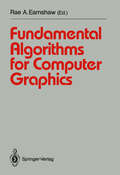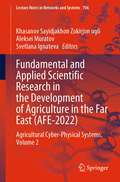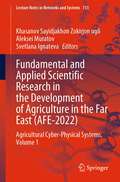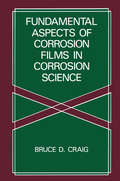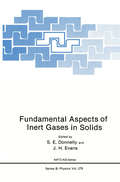- Table View
- List View
Functionalized Smart Nanomaterials for Point-of-Care Testing (Smart Nanomaterials Technology)
by Amit Kumar Mandal Suvankar Ghorai Azamal HusenThis book highlights the recent advancement in point-of-care testing (POCT) technologies utilizing ‘smart’ nanomaterials for the analysis of biomarkers related to disease, which includes metabolites, enzymes, proteins, nucleic acids, cancer cells and multidrug-resistant pathogen. The POCT refers to medical diagnostic tests performed near the place and time of patient care. During the recent pandemic of COVID-19, many realized the importance of affordable, rapid and accurate POCT devices and their usefulness to combat the spread of the infection. The chapters in this book describe the emergence of ‘smart’ nanomaterials with unique physical and chemical properties being utilized in POCT devices for immobilizing biorecognition elements and labels for signal generation, transduction and amplification. It showcases the applications of these smart nanomaterials and their superiority in developing point-of-care diagnostics devices in a wide range of applied fields like food industry, agriculture sector, water quality assessment, pharmaceuticals and tissue engineering. It also looks into the challenges associated and future direction of research in this promising field. This book caters as reference book for researches from the field of nanobiotechnology and biomedical sciences who are interested in the development of rapid, affordable and accurate POCT devices.
Functionalized Two-Dimensional Black Phosphorus and Polymer Nanocomposites as Flame Retardant: Preparation and Properties (Springer Theses)
by Shuilai QiuThis thesis details the novel preparation methods and the improved properties of two-dimentional (2D) black phosphorene (BP) and the polymer nanocomposites. Various surface treatment methods are used, and through these designs, better mechanical, thermal and flame retardant properties are achieved for these functionalized materials, thus reducing the fire risk of the polymer composite system.
Functionalizing Graphene and Carbon Nanotubes: A Review (SpringerBriefs in Applied Sciences and Technology)
by Filipe Vargas Ferreira Luciana De Cividanes Felipe Sales Brito Beatriz Rossi Menezes Wesley Franceschi Evelyn Alves Nunes Simonetti Gilmar Patrocínio ThimThis book compiles all current information on the different types of functionalization of carbon nanotubes (CNTs) and graphene, both covalent and non-covalent. The book starts with a general overview of the synthesis, characterization and application of functionalized CNTs and graphene. Special attention is dedicated to the characterization of functionalized materials, a topic rarely addressed on the literature. The authors provide a comparison between the functionalization of these two types of carbon materials.
Functionally Graded Materials (Topics in Mining, Metallurgy and Materials Engineering)
by Rasheedat Modupe Mahamood Esther Titilayo AkinlabiThis book presents the concept of functionally graded materials as well as their use and different fabrication processes. The authors describe the use of additive manufacturing technology for the production of very complex parts directly from the three dimension computer aided design of the part by adding material layer after layer. A case study is also presented in the book on the experimental analysis of functionally graded material using laser metal deposition process.
Functionally Graded Materials: Design, Processing and Applications (Materials Technology Series #5)
by Y. Miyamoto W. A. Kaysser B. H. Rabin A. Kawasaki R. G. FordSeven years have elapsed since Dr. Renee Ford, editor-in-chief of Materials Technology, first suggested to me to publish a book on Functionally Graded Materials (FGMs). She said that the FGM concept, then largely unknown outside of Japan and a relatively few laboratories elsewhere, would be of great interest to everyone working in the materials field because of its potentially universal applicability. There was no book about FGMs in English at that time, although the number of research papers, review articles, and FGM conference proceedings had been increasing yearly. We discussed what the book should cover, and decided it should present a comprehensive description from basic theory to the most recent applications of FGMs. This would make it useful both as an introduction to FGMs for those simply curious about what this new materials field was all about, and also as a textbook for researchers, engineers, and graduate students in various material fields. The FGM Forum in Japan generously offered to support this publication program. is very difficult for an individual author to write a book that Because it covers such a wide range of various aspects of many different materials, I invited more than 30 eminent materials scientists throughout the world, who were associated with FGM research, to contribute selected topics. I also asked several leading researchers in this field to edit selected chapters: Dr. Barry H. Rabin, then at the U. S.
Functionally Graded Materials (FGMs): Fabrication, Properties, Applications, and Advancements
by Pulak M. Pandey Sandeep Rathee Manu Srivastava Prashant K. JainThe science and study of functionally graded materials (FGMs) have intrigued researchers over the last few decades. Their application has the capability to produce parts with unmatched properties which are virtually impossible to obtain via conventional material routes. This book addresses various FGM aspects and provides a relevant, high-quality, and comprehensive data source. The book covers trends, process classification on various bases, physical processes involved, structure, properties, applications, advantages, and limitations. Emerging trends in the field are discussed in detail and advancements are thoroughly reviewed and presented to broaden the spectrum of FGM applications. This reference book will be of interest to scholars, researchers, academicians, industry practitioners, government labs, libraries, and anyone interested in the area of materials engineering.
Functionally Graded Materials (FGMs): Fabrication, Properties, Applications, and Advancements
by Pulak M. Pandey, Sandeep Rathee, Manu Srivastava, and Prashant K. JainThe science and study of functionally graded materials (FGMs) have intrigued researchers over the last few decades. Their application has the capability to produce parts with unmatched properties which are virtually impossible to obtain via conventional material routes. This book addresses various FGM aspects and provides a relevant, high-quality, and comprehensive data source. The book covers trends, process classification on various bases, physical processes involved, structure, properties, applications, advantages, and limitations. Emerging trends in the field are discussed in detail and advancements are thoroughly reviewed and presented to broaden the spectrum of FGM applications. This reference book will be of interest to scholars, researchers, academicians, industry practitioners, government labs, libraries, and anyone interested in the area of materials engineering.
Functionally Graded Materials in the 21st Century: A Workshop on Trends and Forecasts
by Kiyoshi IchikawaI am honored to chair this International Workshop on Functionally st Graded Materials in the 21 Century: A Workshop on Trends and Forecasts, and would like to first express my sincere gratitude to everyone participating. The Mechanical Engineering Laboratory and the Japan International Science and Technology Exchange Center (JISTEC) have co-organized this workshop with the sponsorship of the Science and Technology Agency of Japan and the cooperation of the Association of Mechanical Technology. This workshop is an international conference to focus on functionally graded materials and the aim is to provide an overview of the present global technical trends and the future development of functionally graded materials over the next 10 years. I am very happy to see many researchers meeting together here - including seven researchers invited from abroad. During the three-day oral sessions, 36 research reports will be presented, and I'm sure I'm not the only one who is very anxious to hear and participate in the upcoming interesting discussions. At present, the Mechanical Engineering Laboratory is conducting fundamental and ground-breaking research in such major areas as materials science and technology, bioengineering, information & system science, advanced machine technology, energy technology, manufacturing technology and robotics. In particular, we consider research on materials science and technology to have the highest priority for the 21st century. and since 1996 have participated in the US-Japan joint research project, Precompetitive Processing and Characterization of Functionally Graded Materials.
Functioning and Management of European Beech Ecosystems (Ecological Studies #208)
by Rainer Brumme Partap K. KhannaTemperate forests cover large areas of Europe and perform a number of important functions such as the regulation of energy and matter, production of wood and other resources, and conservation of biodiversity and habitats; they also have special signi?cance in social and cultural contexts. Initiated in 1960s, the ?rst International Biological Program (IBP) focused on ‘‘the biological basis of productivity and human welfare. ’’ As the German contribution to the IBP, ecosystem research has been carried out since 1966 in the Solling area (Ellenberg H. , Ecological Studies 2, 1971), an upland region in Northwest Germany. This study provided clear evidence that the stability of forest ecosystems was threatened by the high inputs of at- spheric pollutants. This promoted many interdisciplinary research programs which were coordinated by Prof. Dr. Bernhard Ulrich and the Forest Ecosystems Research Center of the University of Go¨ttingen. This involved, in addition to the Solling site, the establishment of two other sites for long-term monitoring of ecosystem pro- ¨ cesses. The two contrasting sites were established in 1980 at Gottinger Wald on base-rich calcareous soil and in 1989 at Zierenberg on volcanic soil. These projects were funded initially by the Federal Ministry of Research and Technology (BMBF) as interdisciplinary projects under the titles: ‘‘Conditions of Stability of Forest Ecosystems’’ (1989–1993), and ‘‘Dynamics of Forest Ecos- tems’’ (1993–1998). The primary goal of these studies was to quantify the ecolo- cal condition of forests in a changing environment and element ?uxes.
Functions, Spaces, and Expansions: Mathematical Tools in Physics and Engineering (Applied and Numerical Harmonic Analysis)
by Ole ChristensenThis graduate-level textbook is a detailed exposition of key mathematical tools in analysis aimed at students, researchers, and practitioners across science and engineering. Every topic covered has been specifically chosen because it plays a key role outside the field of pure mathematics. Although the treatment of each topic is mathematical in nature, and concrete applications are not delineated, the principles and tools presented are fundamental to exploring the computational aspects of physics and engineering. Readers are expected to have a solid understanding of linear algebra, in Rn and in general vector spaces. Familiarity with the basic concepts of calculus and real analysis, including Riemann integrals and infinite series of real or complex numbers, is also required.
Fundamental Algorithms for Computer Graphics: NATO Advanced Study Institute directed by J.E. Bresenham, R.A. Earnshaw, M.L.V. Pitteway (Springer Study Edition)
by J. E. Bresenham R. A. Earnshaw M.L.V. PittewayAlgorithms provide the basic foundation for all computational processes. This volume presents algorithms at the foundational level and also at the various levels between this level and the user application. Some of these algorithms are classical and have become well established in the field. This material is therefore a rich source of information and is still relevant and up to date. The basic primitives of computer graphics have remained unchanged: lines, circles, conics, curves and characters. This volume contains reference material in all these areas. The higher levelsof contouring and surface drawing are also well covered. Developments in hardware architectures have continued since the first printing, but the basic principles of hardware/software trade-offs remain valid. This reprint is being published as a Study Edition to make the material more accessible to students and researchers in the field of computer graphics andits applications. The continuing popularity of the original book demonstrates the value and timeliness of its contents.
Fundamental Algorithms in Computational Fluid Dynamics (Scientific Computation)
by Thomas H. Pulliam David W. ZinggIntended as a textbook for courses in computational fluid dynamics at the senior undergraduate or graduate level, this book is a follow-up to the book Fundamentals of Computational Fluid Dynamics by the same authors, which was published in the series Scientific Computation in 2001. Whereas the earlier book concentrated on the analysis of numerical methods applied to model equations, this new book concentrates on algorithms for the numerical solution of the Euler and Navier-Stokes equations. It focuses on some classical algorithms as well as the underlying ideas based on the latest methods. A key feature of the book is the inclusion of programming exercises at the end of each chapter based on the numerical solution of the quasi-one-dimensional Euler equations and the shock-tube problem. These exercises can be included in the context of a typical course and sample solutions are provided in each chapter, so readers can confirm that they have coded the algorithms correctly.
Fundamental and Applied Aspects of Nonionizing Radiation
by Solomon MichaelsonDuring the last 30 years, there has been a remarkable devel opment and increase in the number of processes and devices that utilize or emit non-ionizing radiant energies such as micro waves, a form of electromagnetic wave energy and ultrasound representative of mechanical vibration. These energies are used in all sectors of our society for military, industrial, telecommunications, medical, and consumer applications. More recently, the use of ultrasound in biology and medicine has been considerably expanded. These increases in sources of non ionizing radiant energy have resulted in growing interest on the part of government regulatory agencies, industrial and mili tary physicians, research workers, clinicians, and even environ mentalists. Although there is information on biologic effects and potential hazards to man from exposure to microwaves or ultrasound, considerable confusion and misinformation has permeated not only the public press but also some scientific and technical publications. Interest in the biologic effects of high frequency currents developed in the beginning of the present century. This was followed by the introduction of "u1trashortwave" therapy. During the latter part of World War II, the U. S. military services became interested in the possible hazards to personnel working around microwave sources, and the Office of Naval Research of the U. S. Navy began to sponsor research on the biologic effects of microwaves in 1948. In 1956, the U. S.
Fundamental and Applied Nano-Electromagnetics: Thz Circuits, Materials, Devices (NATO Science for Peace and Security Series B: Physics and Biophysics)
by Antonio Maffucci Sergey A. MaksimenkoThis book presents the most relevant and recent results in the study of “Nanoelectromagnetics”, a recently born fascinating research discipline, whose popularity is fast arising with the intensive penetration of nanotechnology in the world of electronics applications. Studying nanoelectromagnetics means describing the interaction between electromagnetic radiation and quantum mechanical low-dimensional systems: this requires a full interdisciplinary approach, the reason why this book hosts contributions from the fields of fundamental and applied electromagnetics, of chemistry and technology of nanostructures and nanocomposites, of physics of nano-structures systems, etc. The book is aimed at providing the reader with the state of the art in Nanoelectromagnetics, from theoretical modelling to experimental characterization, from design to synthesis, from DC to microwave and terahertz applications, from the study of fundamental material properties to the analysis of complex systems and devices, from commercial thin-film coatings to metamaterials to circuit components and nanodevices.The book is intended as a reference in advanced courses for graduate students and as a guide for researchers and industrial professionals involved in nanoelectronics and nanophotonics applications.
Fundamental and Applied Nano-Electromagnetics II: THz Circuits, Materials, Devices (NATO Science for Peace and Security Series B: Physics and Biophysics)
by Antonio Maffucci Sergey A. MaksimenkoThe increasing prevalence of nanotechnologies has led to the birth of “nanoelectromagnetics,” a novel applied science related to the interaction of electromagnetic radiation with quantum mechanical low-dimensional systems. This book provides an overview of the latest advances in nanoelectromagnetics, and presents contributions from an interdisciplinary community of scientists and technologists involved in this research topic. The aspects covered here range from the synthesis of nanostructures and nanocomposites to their characterization, and from the design of devices and systems to their fabrication. The book also focuses on the novel frontier of terahertz technology, which has been expanded by the impressive strides made in nanotechnology, and presents a comprehensive overview of the: - synthesis of various nanostructured materials; - study of their electrical and optical properties; - use of nano-sized elements and nanostructures as building blocks for devices; - design and fabrication of nanotechnology devices operating in the THz, IR and optical range. The book introduces the reader to materials like nanocomposites, graphene nanoplatelets, carbon nanotubes, metal nanotubes, and silicon nanostructures; to devices like photonic crystals, microcavities, antennas, and interconnects; and to applications like sensing and imaging, with a special emphasis on the THz frequency range.
Fundamental and Applied Scientific Research in the Development of Agriculture in the Far East: Agricultural Cyber-Physical Systems, Volume 2 (Lecture Notes in Networks and Systems #706)
by Khasanov Sayidjakhon Zokirjon ugli Aleksei Muratov Svetlana IgnatevaThe book presents a collection of scientific research in the field of agriculture cyber-physical systems (ACPSs). The methods and tools for agricultural systems design, estimation and monitoring are proposed in this book. The book presents technical developments in the robotics and IoT sector, new solutions with drones, sensors and smart agriculture machines, solutions to digitize the farmer's life by delivering holistic management platforms and monitoring systems, as well as studies devoted to the field mapping. Research on creating a digital twin of the supply chain to predict the near-future state of the supply chain are also presented in this book. The book contains proceedings of the conference "Fundamental and Applied Scientific Research in the Development of Agriculture in the Far East" (AFE-2022, Tashkent, Uzbekistan). The book allows optimizing agricultural production, maximizes their yield and minimizes losses with efficient use of resources and decreases skilled labor.
Fundamental and Applied Scientific Research in the Development of Agriculture in the Far East: Agricultural Cyber-Physical Systems, Volume 1 (Lecture Notes in Networks and Systems #733)
by Khasanov Sayidjakhon Zokirjon ugli Aleksei Muratov Svetlana IgnatevaThe scope of this book is cyber-physical systems used for the sustainable development and productivity of the agricultural sector. The book contains proceedings of the conference “Fundamental and Applied Scientific Research in the Development of Agriculture in the Far East” (AFE-2022, Tashkent, Uzbekistan). The results of research in the following areas are presented here: software-as-a-service solutions for orchard management, ICT components of Smart Agriculture (SA), farm management platforms, yield monitoring and estimation, IoTs in farming, water management, and smart agriculture machines. The book contains information on the latest technologies in precision agriculture, including real-time technology and big data analytics, fertilizer and sprayer controllers, robotics, variable rate irrigation, networks and remote sensing technologies, etc. The research results presented in the book help in making the right decisions about the allocation of resources in agricultural systems.
Fundamental and Applied Scientific Research in the Development of Agriculture in the Far East: Agricultural Innovation Systems, Volume 2 (Lecture Notes in Networks and Systems #354)
by Aleksei Muratov Svetlana IgnatevaThis book uses digital technologies for the sustainable development and productivity of the agricultural sector. The book presents technical developments in the IoT sector, sensors and smart agriculture machines, as well as solutions to digitize the farmer's life by delivering holistic management platforms and monitoring systems. The papers presented in the book are proceedings of the conference “Fundamental and Applied Scientific Research in the Development of Agriculture in the Far East (AFE-2021)”, which took place in Ussuriysk, Russia. Innovative developments in the field of precision livestock farming, application of fertilizers of a new generation and production of eco-friendly products are presented here. This book is an indispensable tool for farming in any climatic conditions and any climatic zones, since it shares the experience of sustainable farming in the Far East region, which is very valuable in conditions of a changing climate and stricter requirements of the market. The research results presented in the book will help in making the right decisions about the allocation of resources in agricultural systems. The book will allow increasing awareness about the benefits of precision livestock farming, optimizing agricultural production, helping the farmers maximize their yield and minimize losses with efficient use of resources and decreasing skilled labor in agriculture.
Fundamental and Applied Scientific Research in the Development of Agriculture in the Far East: Agricultural Innovation Systems, Volume 1 (Lecture Notes in Networks and Systems #353)
by Aleksei Muratov Svetlana IgnatevaThis book contains new ideas on farming processes, describes new analytical methods that are applicable to a broad range of agricultural systems, and presents new technologies and solutions, which help agricultural systems to function in the modern conditions of digitalization and a changing climate. The results of scientific research presented within the framework of the conference “Fundamental and Applied Scientific Research in the Development of Agriculture in the Far East (AFE-2021)”, which took place in Ussuriysk, Russia are covering the following topics: precision livestock farming, farm management platforms, yield monitoring and estimation, IoTs in farming, water management, smart agriculture machines. These new ideas outlined in the book are future-oriented and are expected to stimulate community debate on determining future directions for advancing agricultural research worldwide. The book is focused on the study of interactions between the components of agricultural systems, between their hierarchical levels, between different types of land use systems, and between agricultural systems and the economic environment. The methods and tools for agricultural systems design, estimation and monitoring are proposed in this book. Studies presented here allow improving the environmental and economic performance of agricultural systems. This book is of particular importance for professionals, scholars, and researchers in the field of agriculture and livestock farming, as well as for the heads and top managers of agricultural enterprises, since materials described in the book will help them in making right decisions.
Fundamental and Practical Aspects of Tribology
by Andreas Rosenkranz Diana Berman Max MarianFundamental and Practical Aspects of Tribology introduces the rudiments of engineering surfaces and teaches the basic phenomena of interacting surfaces in relative motion, major modes of friction and wear, and theories of contact evolution and lubrication. Fundamental topics include friction, wear, and lubrication; surface properties and surface topography; friction of surfaces in contact; wear and surface failures; biotribology; boundary lubrication; fluid properties; hydrodynamic lubrication; bearing selection; and introductory micro‑ and nanotribology. This book also considers the relationship between nano‑ and macrotribology, rolling contacts, tribological problems in magnetic recording and electrical contacts, and monitoring and diagnosis of friction and wear. Offers a comprehensive review of the fundamentals, providing basic information for scientists and engineers just being introduced to the tribology field Teaches tribological methods of measurements and characterization Includes examples of real‑life tribological problems and case studies of engineering problems and solutions Gives an overview of current advancements in the field Features end‑of‑chapter problems and video content for reinforcement of material This textbook is written for students taking courses in tribology and lubrication, as well as surface engineering. It will also appeal to scientists and engineers who are new to tribology.The text also offers sample laboratory demonstrations available to qualifying adopting professors.
Fundamental and Practical Aspects of Tribology
by Andreas Rosenkranz Diana Berman Max MarianFundamental and Practical Aspects of Tribology introduces the rudiments of engineering surfaces and teaches the basic phenomena of interacting surfaces in relative motion, major modes of friction and wear, and theories of contact evolution and lubrication. Fundamental topics include friction, wear, and lubrication; surface properties and surface topography; friction of surfaces in contact; wear and surface failures; biotribology; boundary lubrication; fluid properties; hydrodynamic lubrication; bearing selection; and introductory micro‑ and nanotribology. This book also considers the relationship between nano‑ and macrotribology, rolling contacts, tribological problems in magnetic recording and electrical contacts, and monitoring and diagnosis of friction and wear. Offers a comprehensive review of the fundamentals, providing basic information for scientists and engineers just being introduced to the tribology field Teaches tribological methods of measurements and characterization Includes examples of real‑life tribological problems and case studies of engineering problems and solutions Gives an overview of current advancements in the field Features end‑of‑chapter problems and video content for reinforcement of material This textbook is written for students taking courses in tribology and lubrication, as well as surface engineering. It will also appeal to scientists and engineers who are new to tribology.The text also offers sample laboratory demonstrations available to qualifying adopting professors.
Fundamental Aspects of Corrosion Films in Corrosion Science
by B.D. CraigThe purpose of this book is to stimulate thinking among corrosion scientists and engineers to examine corrosion mechanisms and corro sion control from another perspective. While the presence of corro sion films in electrochemical corrosion has been recognized for over a century, the contribution of these films to all facets of corrosion has not been explored to a significant degree. Rather the role of films in certain mechanisms (i.e., stress corrosion cracking) has been empha sized, yet almost ignored for other corrosion mechanisms. This is viewed by the author as solely attributable to the lack of investigation into, and an understanding of, the contribution of films to these mech anisms or forms of attack. The lack of emphasis and study of corrosion films and their contribution to all forms of corrosion attack are probably the result of current university instruction that utilizes two popular corrosion texts (Uhlig and Fontana and Greene) for teaching. These texts provide an excellent understanding at the undergraduate level of corrosion funda mentals; however, the major implicit premise in these texts is that bulk properties of an alloy or metal control the corrosion resistance in a particular environment. For many applications and for a simple under standing of corrosion mechanics, this approach is sufficient. Yet, research on corrosion films indicate these films often have an entirely different composition than the bulk metal (ratio of alloying elements).
Fundamental Aspects of Inert Gases in Solids (Nato Science Series B: #279)
by S. E. Donnelly J. H. EvansThe NATO Advanced Research Workshop on Fundamental Aspects of Inert Gases in Solids, held at Bonas, France from 16-22 September 1990, was the fifth in a series of meetings that have been held in this topic area since 1979. The Consultants' Meeting in that year at Harwell on Rare Gas Behaviour in Metals and Ionic Solids was followed in 1982 by the Jiilich Inter national Symposium on Fundamental Aspects of Helium in Metals. Two smaller meetings have followed-a CECAM organised workshop on Helium Bubbles in Metals was held at Orsay, France in 1986 while in February 1989, a Topical Symposium on Noble Gases in Metals was held in Las Vegas as part of the large TMS/AIME Spring Meeting. As is well known, the dominating feature of inert gas atoms in most solids is their high heat of solution, leading in most situations to an essentially zero solubility and gas-atom precipita tion. In organising the workshop, one particular aim was to target the researchers in the field of inert-gas/solid interactions from three different areas--namely metals, tritides and nuclear fuels-in order to encourage and foster the cross-fertilisation of approaches and ideas. In these three material classes, the behaviour of inert gases in metals has probably been most studied, partly from technological considerations-the effects of helium production via (n, a) reac tions during neutron irradiation are of importance, particularly in a fusion reactor environ ment-and partly from a more fundamental viewpoint.
Fundamental Aspects of Silicon Oxidation (Springer Series in Materials Science #46)
by Yves J. ChabalDiscusses silicon oxidation in a tutorial fashion from both experimental and theoretical viewpoints. The authors report on the state of the art both at Lucent Technology and in academic research. The book will appeal to researchers and advanced students.









